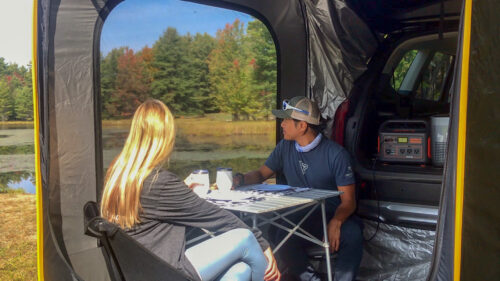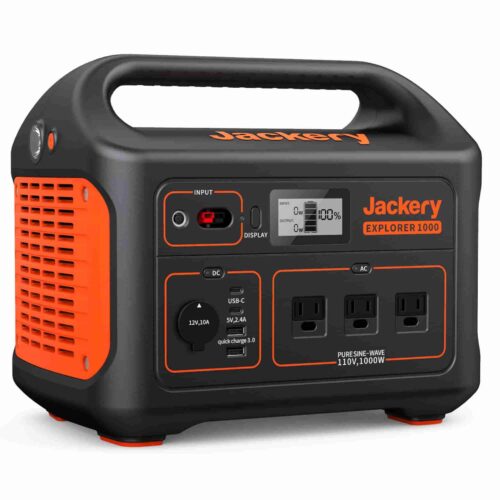
Move Over Van Life, Car Glamping is Micro-RVing
By Erik Trinidad

“Glamping” is already the portmanteau of “glamorous” and “camping,” but affix the word “car” before it—i.e. “Car Glamping”—and the phrase becomes even more of an oxymoron.
Camping in a car, glamorous? It can certainly be if you accessorize your everyday SUV with an air mattress and comfortable bedding, a mobile kitchen unit with a refrigerator/freezer, and other gear that can easily be stored in the trunk of a car and in a roof cargo box.
Car Glamping: It’s a Thing!
“Car Glamping” is a self-described activity that lies somewhere in between camping and “van life.” In recent years, so-called “van life” has become the label (and hashtag) for that trendy, nomadic lifestyle of living out of a van, embraced by many free-spirited Millennials and Gen Xers—before it was given a reality check by the Oscar-winning film Nomadland, starring boomer Frances McDormand.
Van life’s appeal is not only about impromptu, Instagrammable adventures on the open road, but that it’s a cost-effective alternative to RV life.
However, the reality is both RVs and vans don’t come without a huge commitment and cost. I’ve looked into the pricing of van conversions, only to be a little discouraged—estimates range from $10K–$100K—but then I realized that I actually don’t need a van or expensive RV to pursue a similar “van life” of adventure.

That’s because, with all the available camping gear and gadgets that are car-compatible today, anyone can pursue that life, on long weekends and beyond, with an everyday SUV. “Car Glamping,” as I define it on my website CarGlamping.com, is for those who want to embrace multi-day outdoor adventures, using a car as a basecamp—but without skimping on comforts, conveniences, or even a few luxuries.
Sleep On It
Whether you’re using a Subaru, Jeep, or Toyota 4Runner, there are plenty of car mattresses available on the market, in various sizes to suit your available space. Simply fold down your car’s back seats down to expand the rear cargo space, and you already have a mattress platform.
Expand your mattress area even more by moving up the front seats and placing inflatable footrests in the backseat’s footwells to level off the gaps. For smaller vehicles, I’ve seen videos of people building lofted wooden platforms to truly maximize their interior area. However you do it, once you have a flat space for your mattress, Amazon and other retailers have many options for your configuration.
Kia Telluride
Personally, I’m Car Glamping with a 2020 Kia Telluride, and I’ve graduated from the cheaper inflatable mattresses that kept leaking air on me.
I invested in a higher-end Luno mattress, built by the California-based company that makes sturdy, yet comfortable full-size mattresses specifically for road vehicles. In fact, they have a mattress stock tailored to maximize the spaces of over 1,800 automobiles.
No need for sleeping bags; I use a fitted sheet—also from Luno, which truly conforms to their mattresses’ car-fitting shapes—plus a microfiber sheet, a lightweight insulated blanket, and compressible Thermarest pillows in soft pillowcases that squeeze down to about a third their size when stored.
For privacy, I have a windshield cover for the front, and then shaded mosquito nets that fit over all my windows, so that I can let the breeze in—while keeping bugs out. When configured with the optimal conditions, my Car Glamping bed is a comfortable, breezy, bug-free sanctuary of slumber. I even strategically set my pillows under the moonroof, should I be inclined to look up at the stars on a clear night.

From SUV to Micro RV
When the bed takes up most of the car’s interior space, there are different ways to expand outwards with packable awnings and tailgate tents—thus, converting an everyday SUV into a provisional “micro RV.”
For me, the dwelling space of my Telluride extends outward from the trunk with Mogics’ CARSULE, a 6-foot cube-shaped tent that compresses down to a 5-inch thick circular pack just 34 inches in diameter—easily storable in my roof cargo box.
Easily propped up with small support poles and a little help from the opened rear hatch door, the CARSULE is a relatively spacious pop-up cabin with ample headroom and large mosquito netted windows on three sides.
After I unpack and assemble camp chairs and a table inside, this cubed tent essentially becomes a living room/dining room/remote office. And if I want to make it a movie night, I can simply put a projector on the table and zip one of the window shades closed to use as a projector screen.
This multipurpose space also serves as a covered, yet ventilated kitchen, for when I pull out the stove and griddle from an ingenious cooking unit that slides right out from the trunk.

Everything, even the Kitchen Sink

Marie Kondo would approve of the Indiegogo-crowdfunded Nomad Kitchen, a low-profile kitchen kit that I easily mounted into my SUV’s trunk, without tools, by ratcheting support straps hooked onto car seat and cargo loops.
Like a 4-foot-long drawer, the inside slides out to reveal a stainless-steel washbasin to pair with a spigot-compatible water jug, a drying rack conveniently covered with a bamboo cutting board, and a two-burner gas stove.
The drying rack and sink double as storage for my coffee percolator and utensils, and underneath the stove, there’s just enough space to store a cast iron griddle—perfect for when I grill up steaks for my fellow Car Glampers.
That’s everything needed to prepare meals, but to keep ingredients fresh, I also have a refrigerator/freezer. There are many out on the market of varied volumes—an indicator that car camping gear is truly a trend—and I have the 20-liter ICECO GO20, whose thermostat is an iPhone app linked via Bluetooth. With the option to sustain two climates (there are two compressors), one side can keep ice cream from melting, while the other side can keep milk, eggs, and beer chilled.

Powerhouse
The car engine may be off when I’m Car Glamping, but that doesn’t mean the refrigerator/freezer is draining my battery.
These days, several companies offer portable power stations that can provide electricity—independent of the car— for just about everything you need, whether it be your phone or battery rechargers, or a portable blender to make breakfast smoothies.
Cleaner and more environmentally friendly than the gas-powered electric generators of yesteryear, these power stations are essentially hefty Lithium-ion battery-powered inverter generators.

I invested in the popular Jackery Explorer 1000, which is only about the size of a lunch cooler, and it keeps my fridge running for about four days without a recharge.
Recharging can easily be done three ways: from a lighter socket while I’m driving, via an electrical outlet when I’m home, or, if I’m not going anywhere for a while, by the power of the sun—with a Renogy solar panel mounted on my cargo box, or by an array of two Jackery 100W solar panels that can easily be moved into sunny patches.
With a renewable energy source on any sunny day, I could potentially be off the grid for outdoor adventures for days or even months—or at least until I need more provisions.
Easy Recharging
Recharging can easily be done three ways: from a lighter socket while I’m driving, via an electrical outlet when I’m home, or, if I’m not going anywhere for a while, by the power of the sun—with an array of two Jackery 100W solar panels that fold flat when stored.

With a renewable energy source on any sunny day, I could potentially be off the grid for outdoor adventures for days or even months—or at least until I need more provisions.
As for the bathroom, I’m still dependent on a campground’s facilities, but only because I have yet to invest in a portable toilet solution or mobile shower—both things that already exist on the market today.
Collectively, all this gear can truly make a car the heart of a campsite—rather than a transport vehicle parked on the side—just like with a van or RV. It might not be a luxury hotel, but sometimes you just need to “rough it.” If roughing it with just a car can include steaks, wine, and a movie night before sleeping comfortably under the stars, then why not?
Erik Trinidad is a freelance food and travel writer who, during the COVID-19 pandemic, bought a Kia Telluride and started Car Glamping. Web episodes of his Car Glamping experiences can be found at CarGlamping.com. Also follow him on Instagram: @theglobaltrip and @carglamping.
- Fall Clothing for Your Travels - August 30, 2024
- Mekong Chronicles: The River That Shaped Southeast Asia - August 28, 2024
- Gadgets and Goodies You Might Enjoy - August 27, 2024


Very interesting to see what is available for small SUV. It seems like a lot of work to set up and take down for a night if you plan in driving in the area you are visiting. I think I would go with a van because it is just easier. This was an interesting story though.